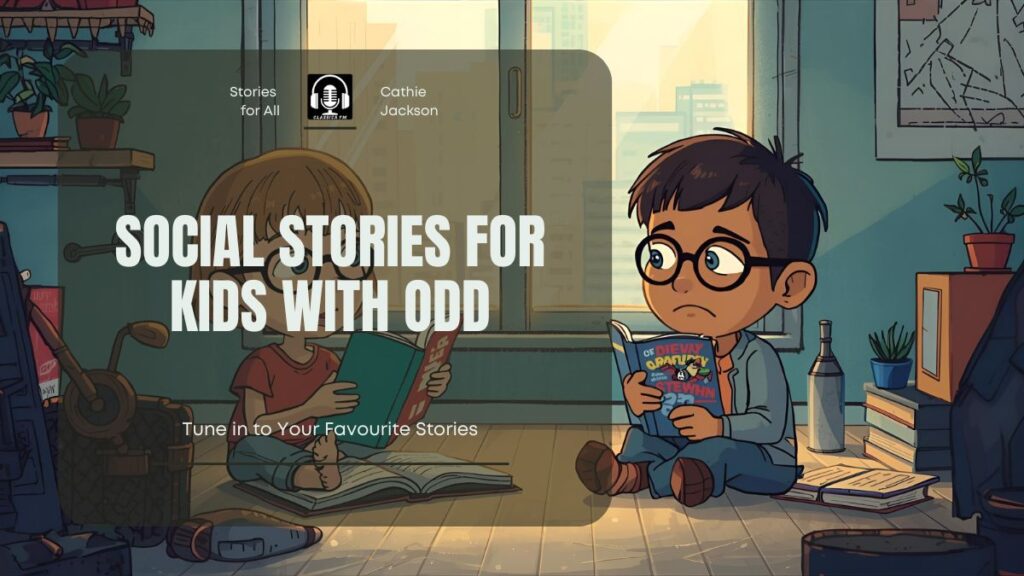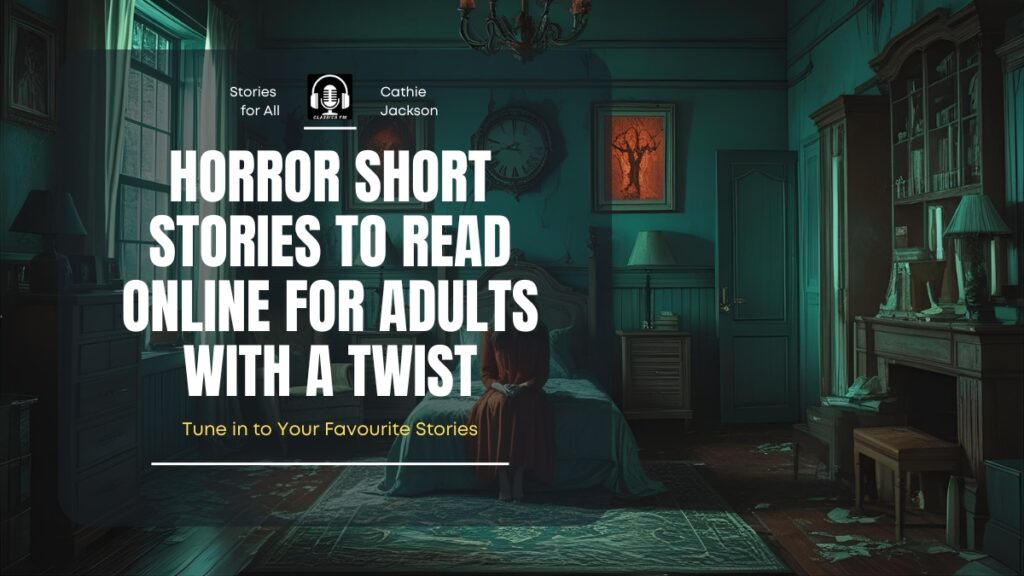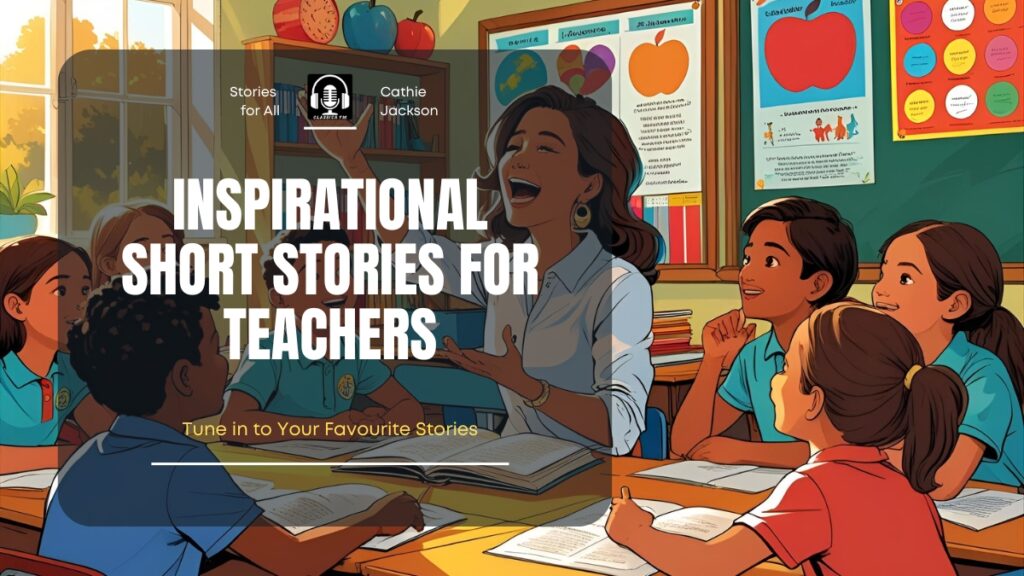Have you ever seen a child completely lose it over something small? Maybe a crayon breaks, a toy gets taken, or a rule feels unfair. To adults, it seems tiny. But for kids with ODD (Oppositional Defiant Disorder), it can feel huge. Faces get red, fists clench, voices get loud, and tears might fall.
Kids with ODD feel emotions strongly. Anger, frustration, sadness—they feel it all more intensely. And they don’t always know how to handle it.
That’s where social stories for kids with ODD help. They are simple, gentle guides that explain what’s happening, why it’s okay to feel upset, and what to do next. These stories give kids a little roadmap for tricky moments, helping them feel calmer, more understood, and more in control.
Social Stories for Kids with Odd
Small moments can feel like big storms for kids with ODD. Social stories can be the gentle guide that helps them navigate those storms—and find calm.
Taking Turns Is Fun
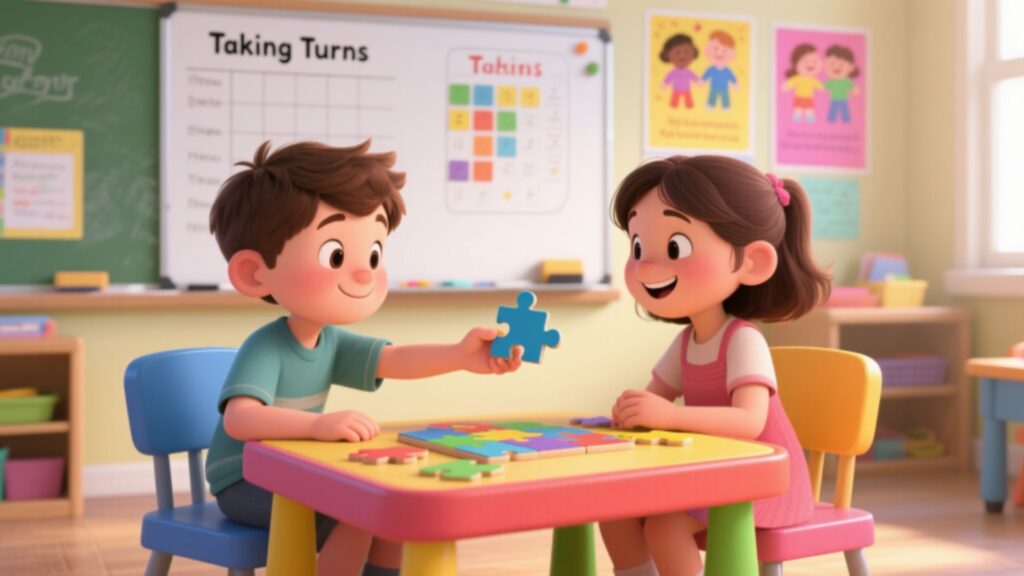
Sam loved toys. He loved them a lot. Blocks. Cars. Dolls. Balls. Anything he could play with.
Sometimes, he didn’t want to share. When he played with his toy car, he wanted it all. If someone touched it, he got upset. His face turned red. His hands clenched. He sometimes shouted.
Sam didn’t want to be mean. He just loved his toys so much.
One morning, Sam was at school. He sat with his cars at the table. His friend Jake walked over.
“Can I play?” Jake asked.
“No!” Sam shouted. He grabbed the red car.
Jake frowned. He walked away. Sam felt something he didn’t like. He felt lonely.
Ms. Clara, his teacher, noticed. She came over.
“Sam,” she said softly, “I have a story for you. It’s about taking turns. Do you want to hear it?”
Sam nodded. He liked stories.
“Once there was a boy named Leo,” Ms. Clara began. “Leo loved blocks. He built tall towers. But he didn’t like to share. He wanted all the blocks for himself. One day, his friend Mia came over. She wanted to play too. Leo said, ‘No! These are my blocks!’”
Sam frowned. That sounded like him.
“Mia looked sad. Leo felt lonely. His tower was big, but he had no one to play with. Then he said, ‘Okay, Mia. You can have some blocks.’”
Sam’s eyes got wide.
“Leo and Mia played together. They laughed. Their towers were taller than ever. Sharing made the game more fun.”
Sam thought about this. Maybe taking turns wasn’t so bad.
The next day, Sam tried it at school. He had his cars again. Jake wanted the red one. Sam first wanted to say no. But he remembered Leo and Mia.
He took a deep breath.
“Jake,” he said, “you can have the red car first. I’ll use the blue one.”
Jake smiled. “Thanks, Sam!”
They raced their cars together. They made up tracks. They cheered for each other. Sam felt happy.
Practice at Home
That afternoon, Sam went home. His little sister, Lily, wanted to play with blocks. Sam wanted to keep all the blocks for himself.
He paused. He remembered Leo and Mia. He remembered the fun he had with Jake.
“You can play with the green block first,” he said. “I’ll use the red one.”
Lily smiled. Sam felt warm inside. He liked seeing her happy.
Sharing didn’t feel so bad. It felt… good.
More Practice at School
Over the next week, Sam tried taking turns with many things. Blocks. Crayons. Balls. Even the swing.
Sometimes he felt upset. Sometimes he wanted everything. But he remembered the story.
He practiced counting to three before grabbing a toy. He practiced taking deep breaths. He practiced saying, “It’s your turn first. I’ll wait.”
Ms. Clara praised him each time. “Great job, Sam! You’re sharing so well.”
Sam felt proud. Pride felt like a little sunshine in his chest. He wanted more of it.
Learning From Mistakes
One day, Sam still got frustrated. He wanted the swing. Another kid was on it.
He stomped his feet. He yelled. He felt like crying.
Ms. Clara knelt next to him. “Sam,” she said softly, “it’s okay to feel upset. What matters is what you do next.”
Sam took a deep breath. He counted to three. Then he said, “Can I have a turn after you?”
The other child smiled. “Sure!”
Sam waited. He felt proud.
Sharing Brings Friends
Soon, Sam noticed something special. The other kids liked playing with him more. Not because he had the most toys. Because he shared. Because he was fair. Because he made them happy.
He realized something else. Sharing wasn’t giving up. Sharing was giving joy. And joy grew when it was shared.
Fun Examples
Sam started noticing chances to take turns everywhere.
At recess, he waited for the slide. It was hard, but fun when he finally went down.
During art time, he shared crayons with his friends. They drew together and made the paper colorful.
At lunch, he let someone go first in line. They said, “Thanks, Sam!” and smiled. Sam smiled back. He liked the smiles.
Home Practice
At home, Sam practiced again. His mom gave him the puzzle. Lily wanted to help.
He felt upset. He wanted to do it alone.
He remembered counting to three. He remembered the story.
“You can put the next piece,” Sam said. “I’ll do the next one after you.”
They worked together. The puzzle finished faster. They laughed. Sam felt proud.
Taking Turns Is Everywhere
Sam started seeing taking turns in many places.
The swing. The slide. The see-saw. The ball. Even TV time.
Sometimes he still felt upset. That was okay. Everyone feels upset sometimes.
The important thing was what he did next. He counted. He breathed. He remembered the story.
Feeling Proud
Every time Sam took a turn, he felt proud. Every time he shared, someone smiled. Every time someone smiled, he felt happy inside.
He learned that taking turns didn’t mean losing. It meant sharing fun. It meant making friends.
Step by Step
Sam didn’t get it right every time. Sometimes he shouted. Sometimes he grabbed. Sometimes he stomped.
But he practiced. Every day, a little better. Every day, a little happier.
Ms. Clara reminded him, “Step by step, Sam. You’re learning.”
A Big Game
One Friday, the class had a big game with balls and blocks.
Sam saw lots of kids waiting for turns. His first thought was, I want it first!
He took a deep breath. He counted to three.
He said, “You can go first. I’ll wait.”
His friends cheered. Sam felt a little sunshine in his chest.
The game was fun. Everyone laughed. Sam laughed. He remembered the story. He remembered Leo and Mia.
Taking turns was fun.
The Lesson
Sam learned something important. Sharing didn’t mean losing toys. It meant sharing happiness.
He learned that when he let someone go first, games were more fun. When he took turns, he felt proud.
He learned that feelings of frustration were normal. The important thing was what he did next. Count, breathe, wait, share.
He learned that joy grows when it is shared.
The Ending
Soon, Sam was the kid everyone wanted to play with. Not because he had the most toys. Because he shared. Because he was fair. Because he made others happy.
And every time he played, he remembered: Taking turns is fun. Sharing is joy. And joy grows when it is shared.
When I Feel Angry
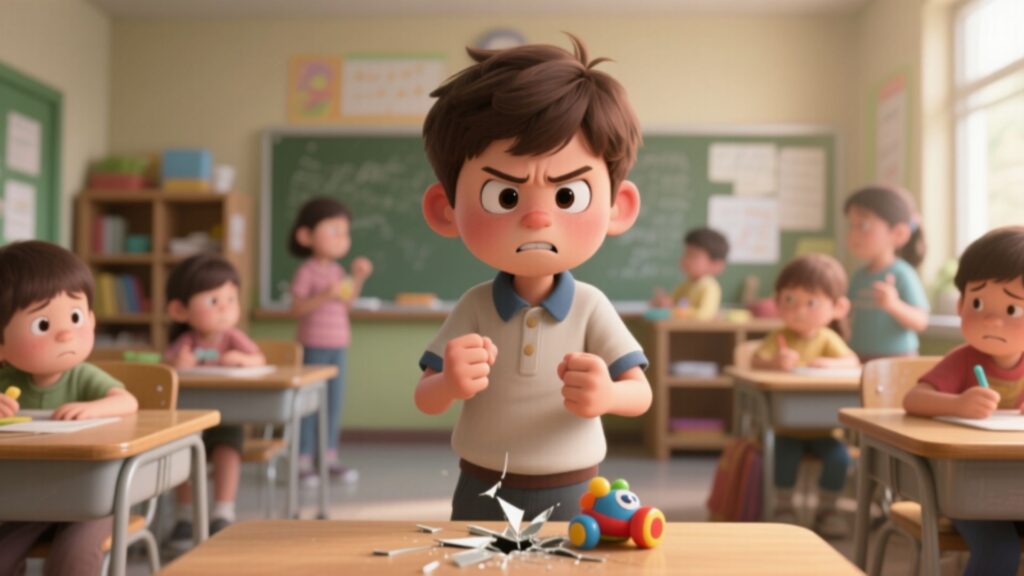
Max felt anger like a storm inside him.
Sometimes it started small. Maybe a toy broke. Maybe someone said no. Maybe he lost a game.
Other times it came fast. Like a fire. His face turned red. His fists clenched. His heart beat fast. His voice got loud.
Max didn’t like feeling this way. But he didn’t know how to stop it.
One morning, Max was building with blocks. He was making a tall tower.
His friend Liam accidentally knocked it over.
Max felt his anger rise. He wanted to shout. He wanted to throw the blocks.
He felt like a volcano ready to explode.
His teacher, Ms. Clara, noticed. She came over.
“Max,” she said softly, “I have a story for you. It’s about feeling angry. Do you want to hear it?”
Max nodded. He liked stories. Stories helped him understand feelings.
“Once there was a boy named Leo,” Ms. Clara began. “Leo loved puzzles. He worked hard on them. One day, his friend Mia touched his puzzle by mistake. It fell apart. Leo felt anger like a storm inside him. He wanted to yell. He wanted to grab the puzzle pieces. He felt like he couldn’t stop.”
Max’s eyes grew wide. That sounded like him.
“Mia looked sad. Leo felt lonely. He didn’t want to be mean, but his anger was too big. Then he remembered something. He remembered to take a deep breath. He counted to three. Then he took another breath. He felt the storm slow down a little.”
Max leaned closer.
“Leo thought, What can I do next? He decided to ask Mia to help him rebuild. He said, ‘Can you help me put the puzzle back together?’ Mia smiled. They worked together. The puzzle was finished faster than before. And Leo felt proud. He felt calm. His anger had gone down, little by little.”
Max thought about this. Maybe anger didn’t have to take over. Maybe he could calm down.
Practicing Calm
The next day, Max tried it at school.
During recess, another boy grabbed the ball he was holding. Max felt his anger rise. His face wanted to turn red. His hands wanted to grab.
Max remembered Leo. He remembered the story. He took a deep breath. He counted to three.
“Can I have a turn next?” Max asked.
The boy smiled. “Sure!”
Max waited. His heart slowed. He felt proud.
Anger Happens at Home
At home, Max had a puzzle. His little sister, Emma, wanted to help. Max felt frustrated. He wanted to do it all himself.
He stomped his foot. He wanted to yell.
Then he remembered Leo. He took a deep breath. He counted to three. He said, “You can put the next piece. I’ll do the next one after you.”
Emma smiled. Max smiled back. The puzzle was done faster. And Max felt proud.
He realized anger could come, but he could choose what to do.
Anger in Real Life
Max noticed anger came in many ways.
Sometimes at school. Sometimes at home. Sometimes with friends.
Sometimes it was big. Sometimes small.
Sometimes he wanted to yell. Sometimes he wanted to hit. Sometimes he wanted to run away.
He learned he could stop. He could breathe. He could count. He could ask for help.
Learning Steps
Ms. Clara taught Max steps for when anger came.
Step 1: Stop.
Step 2: Take a deep breath.
Step 3: Count to three.
Step 4: Think, What can I do next?
Step 5: Choose a safe action.
Max practiced these steps every day.
Sometimes he forgot. Sometimes it didn’t work perfectly. That was okay. He tried again. Step by step, he got better.
Fun Practice
Max made a chart.
Every time he felt anger and used his steps, he got a sticker.
At the end of the week, he counted his stickers. He was proud.
He liked seeing his progress. He liked feeling calm after the storm.
Anger Can Teach
Max realized anger could be helpful.
It told him something mattered. It told him when he needed help. It told him when he wanted something important.
Anger was like a warning light. It didn’t have to hurt him or others.
He just needed to follow his steps.
Anger at the Playground
One day at the playground, Max waited for the swing. Another child got there first.
His anger rose. He clenched his fists.
He remembered Leo. He counted to three. He breathed in. He breathed out.
He said, “Can I have a turn next?”
The other child smiled. Max waited. He felt calm. He swung high. He laughed.
Anger With Friends
At school, Max played a board game.
Another boy accidentally moved Max’s piece. Max felt anger like fire in his chest.
He wanted to shout. He wanted to grab the piece.
He stopped. He breathed. He counted to three. He said, “It’s okay. Let’s keep playing.”
They finished the game. Max felt proud.
He realized anger didn’t have to make him mean.
Anger With Family
At home, Max’s mom asked him to clean his room.
He wanted to play instead. He felt frustrated.
He wanted to yell.
He remembered the story. He took a breath. He counted to three.
He said, “Okay, I’ll clean first. Then I can play.”
His mom smiled. Max smiled. He felt proud.
Anger Can Go Away
Max learned that anger didn’t last forever.
It came fast. It hit hard.
But it could go away if he used his steps.
Breathe. Count. Stop. Think. Choose.
Step by step, the storm slowed.
Max Feels Strong
Max felt stronger every day.
He knew he could feel angry and still be safe.
He knew he could choose his actions.
He knew anger didn’t have to hurt him or others.
Max Helps Others
Sometimes Max saw friends feeling angry.
He reminded them of steps.
“Stop. Breathe. Count to three,” he said.
His friends tried. They felt calm.
Max felt proud. Helping others made him happy.
The Lesson
Max learned something important.
Anger is normal. Everyone feels it.
Anger is not bad. It tells you something matters.
What matters is what you do next.
Breathe. Count. Stop. Think. Choose.
Safe actions make anger go away.
Step by step, day by day, Max got better at managing anger.
He felt calmer. He felt proud. He felt strong.
The Ending
Max still felt anger sometimes.
But now he knew what to do.
He could stop. He could breathe. He could count.
He could choose safe actions.
Max learned that anger didn’t have to control him.
He learned that he could feel angry and still be kind.
He learned that he could feel angry and still feel proud.
And every time he felt the storm coming, he remembered:
When I feel angry, I can stop, breathe, and choose. And anger will go away.
Listening Helps Me Learn
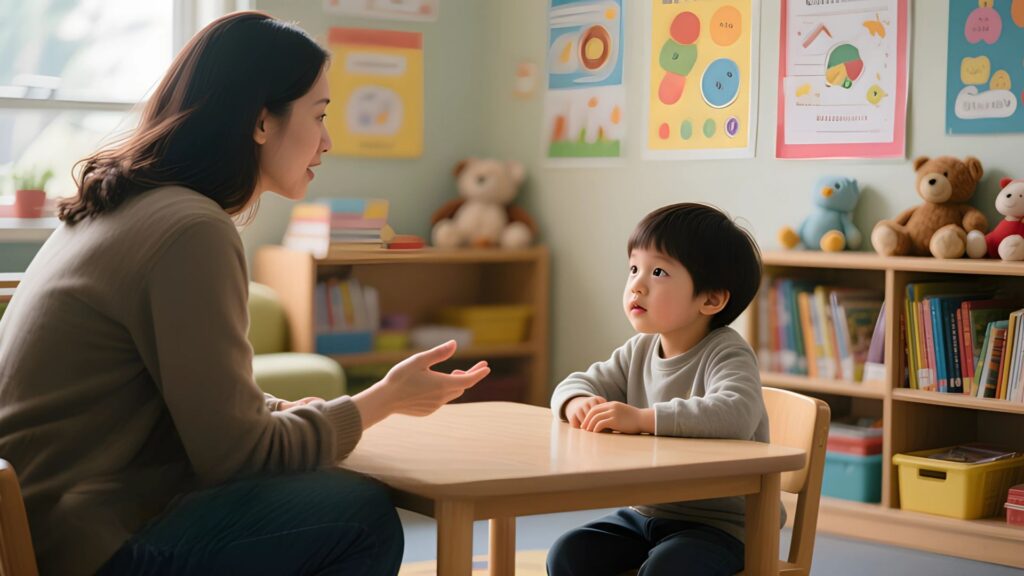
Ella loved to talk. She loved to share her ideas.
Sometimes, she talked so much that she didn’t hear what others were saying.
At school, Ms. Clara noticed. Ella would start an activity and forget the instructions. She would miss important steps.
One day, Ms. Clara said, “Ella, I have a story for you. It’s about listening. Do you want to hear it?”
Ella nodded. She liked stories.
“Once there was a girl named Mia,” Ms. Clara began. “Mia loved to share her ideas. She loved talking to her friends. One day, her teacher gave instructions for a fun art project. Mia started talking to her friends and didn’t listen. She missed the steps. Her picture didn’t turn out right. Mia felt frustrated. She wanted to give up.”
Ella frowned. That sounded familiar.
“Then Mia took a deep breath. She decided to try listening. She looked at the teacher. She heard the instructions carefully. She asked questions. She followed the steps. Her picture turned out great! She felt proud.”
Ella thought about this. Maybe listening could help her too.
Practice at School
The next day, Ms. Clara gave instructions for building a tower with blocks.
Ella wanted to start immediately. She felt excited.
But she remembered Mia. She took a deep breath.
She looked at Ms. Clara. She listened carefully. She followed the steps.
Her tower was taller and stronger than ever.
Ella felt proud. She noticed that listening helped her get better results.
Learning From Mistakes
Sometimes Ella forgot to listen.
Her friends reminded her gently. “Ella, listen,” they said.
She stopped. She took a breath. She focused.
Step by step, she got better. Listening became easier.
Listening at Home
At home, Ella’s mom asked her to help set the table.
Ella wanted to play instead.
Her mom said, “Listen carefully. Plates go on the table first, then cups.”
Ella took a deep breath. She listened. She followed the instructions.
Her mom smiled. “Great job, Ella!”
Ella felt proud.
Fun Practice
Ella made a game. She listened to instructions and checked how many steps she could remember.
She counted stickers for each time she listened carefully.
By the end of the week, she had many stickers. She felt proud and confident.
Listening With Friends
At recess, Ella’s friends wanted to play a game.
They explained the rules. Ella was excited and started talking.
She remembered Mia. She stopped. She listened carefully.
She followed the rules. The game was fun. Everyone laughed. Ella felt happy.
Listening Helps Learning
Ella realized listening helped her in many ways.
At school, she understood lessons better. She finished activities faster. She felt proud.
At home, she followed instructions and helped her family.
With friends, games were more fun when she listened carefully.
Learning Steps for Listening
Ms. Clara taught Ella some simple steps:
Step 1: Stop talking.
Step 2: Look at the person speaking.
Step 3: Take a deep breath.
Step 4: Listen carefully.
Step 5: Ask questions if needed.
Step 6: Follow the instructions.
Ella practiced these steps every day.
Challenges and Success
Sometimes, Ella forgot the steps.
Sometimes, she talked too much.
Sometimes, she felt distracted.
But she tried again. Step by step. Day by day.
She got better and better.
Listening in Real Life
Ella noticed listening was everywhere.
When her mom read a story, listening helped her understand the story.
When her friends gave advice, listening helped her play better.
When her teacher explained a science experiment, listening helped her do it safely.
Feeling Proud
Every time Ella listened carefully, she felt proud.
Every time she followed instructions, she felt confident.
She noticed that listening made her life easier and more fun.
Helping Others
Sometimes, Ella reminded her friends to listen.
“Let’s listen carefully,” she said.
They tried. The activity worked better. They smiled.
Ella felt proud helping her friends.
The Lesson
Ella learned an important lesson:
Listening helps you learn.
Listening helps you follow steps.
Listening helps you finish tasks.
Listening helps you have fun.
Listening helps you feel proud.
Listening helps you understand others.
The Ending
Ella still felt excited and talked a lot sometimes.
But now she remembered Mia. She stopped. She looked. She listened.
She asked questions. She followed instructions.
She felt proud, confident, and happy.
She realized listening wasn’t hard. It just took practice.
And every time she listened carefully, she remembered:
Listening helps me learn. And learning helps me grow.
I Can Say Sorry
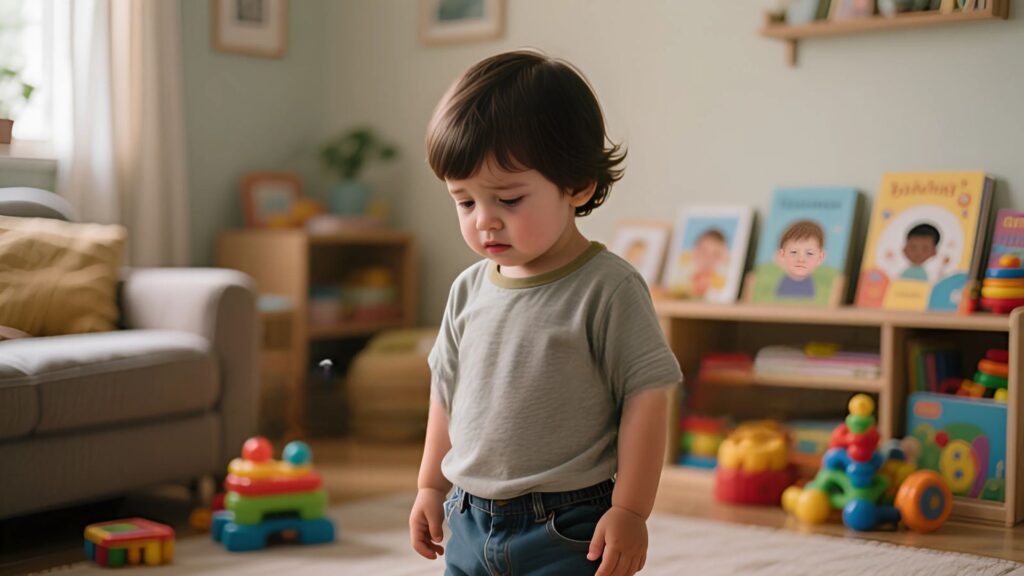
Leo loved to play.
Sometimes, he got upset.
Sometimes, he made mistakes.
Sometimes, he hurt others without meaning to.
One day, Leo was building a tower with blocks.
His friend Mia ran by and knocked it down.
Leo felt angry. His hands clenched. He wanted to shout.
He shouted, “Hey! Watch out!”
Mia looked sad. Her eyes teared up.
Leo felt a strange feeling. Not anger. Not frustration. Something else.
He felt… guilty.
Ms. Clara, his teacher, noticed.
“Leo,” she said gently, “sometimes we hurt people by accident. Saying sorry can help.”
Leo frowned. “I don’t know how.”
Ms. Clara smiled. “I have a story for you. It’s about saying sorry. Want to hear it?”
Leo nodded. He liked stories.
The Story of Mia and Leo
“Once there was a boy named Max,” Ms. Clara began. “Max loved to play with cars. One day, he accidentally bumped his friend’s tower. The tower fell. Max felt angry. He wanted to walk away. But then he noticed his friend looked sad. Max felt guilty. He remembered what his teacher said: saying sorry can help. Max took a deep breath. He said, ‘I’m sorry I knocked your tower down. Can I help you rebuild it?’”
Leo listened carefully.
“His friend smiled. She forgave him. They rebuilt the tower together. It was taller and stronger than before. Max felt proud. His guilt went away. Saying sorry made things better.”
Leo thought about this. Maybe saying sorry could help him too.
Practice at School
The next day, Leo was playing with blocks again.
He accidentally knocked over Mia’s tower.
His first thought was, I don’t want to say sorry.
But he remembered Max. He remembered the story.
He took a deep breath. He said, “I’m sorry, Mia. Can I help you rebuild?”
Mia smiled. “Thanks, Leo!”
They rebuilt the tower together. It was fun.
Leo felt proud. He noticed saying sorry made everyone feel better.
Learning From Mistakes
Leo noticed he still made mistakes sometimes.
Sometimes he bumped someone.
Sometimes he grabbed a toy too quickly.
Sometimes he said something mean without meaning to.
He learned that mistakes happen. Everyone makes them.
The important thing is what you do next.
Saying Sorry at Home
At home, Leo was coloring with crayons.
He accidentally spilled water on his sister’s drawing.
He felt guilty. His hands shook.
He remembered Max. He took a deep breath. He said, “I’m sorry, Emma. Can I help you redo it?”
Emma smiled. She forgave him. Leo felt proud.
Practice and Rewards
Ms. Clara suggested a fun game.
Every time Leo said sorry, he got a sticker.
At the end of the week, he counted his stickers.
He had many. He felt proud and happy.
He realized saying sorry could be easy if he practiced.
Saying Sorry With Friends
During recess, Leo was playing a game.
He accidentally pushed a friend while running.
His first thought was, I don’t want to apologize.
He stopped. He took a breath.
He said, “I’m sorry. Are you okay?”
His friend nodded. They continued playing.
Leo felt happy. He noticed saying sorry could stop fights.
Why Saying Sorry Helps
Leo learned saying sorry helped in many ways.
It made friends happy.
It made him feel proud.
It stopped arguments.
It made games more fun.
It helped everyone feel calm.
Steps to Say Sorry
Ms. Clara taught simple steps:
Step 1: Stop.
Step 2: Take a deep breath.
Step 3: Look at the person.
Step 4: Say, “I’m sorry.”
Step 5: Ask, “Can I help?”
Step 6: Do something kind.
Leo practiced these steps every day.
Challenges and Success
Sometimes, Leo forgot the steps.
Sometimes, he felt shy.
Sometimes, he wanted to run away.
But he tried again. Step by step, day by day, he got better.
He noticed that saying sorry became easier.
Saying Sorry in Real Life
Leo noticed chances to say sorry were everywhere.
At school. At home. At the playground.
Sometimes small. Sometimes big.
Each time, he felt proud afterward.
Feeling Proud
Every time Leo said sorry, he felt proud.
Every time he helped fix a mistake, he felt strong.
He noticed saying sorry didn’t make him weak. It made him brave.
Helping Others
Sometimes, Leo reminded his friends to say sorry.
“It’s okay. Just say sorry,” he said.
His friends tried. They felt better. Leo felt happy helping them.
The Lesson
Leo learned an important lesson:
Everyone makes mistakes.
Saying sorry helps fix mistakes.
Saying sorry makes friends happy.
Saying sorry makes you proud.
Saying sorry is brave.
The Ending
Leo still made mistakes sometimes.
But now he knew what to do.
Stop. Breathe. Say sorry. Help.
He felt proud. He felt calm. He felt happy.
And every time he made a mistake, he remembered:
I can say sorry. Saying sorry helps everyone. And saying sorry makes me proud.
Trying New Things Is Okay

Sophie loved her routine.
She liked doing the same things every day.
Breakfast. Playtime. Drawing. Reading.
She felt safe when she knew what was coming next.
One day, her teacher, Ms. Clara, announced, “Tomorrow, we will try something new—painting with sponges!”
Sophie felt a twist in her stomach.
New? Sponges? What if I make a mistake?
She felt nervous. Her hands fidgeted.
Ms. Clara noticed. She said gently, “It’s okay to feel nervous. Trying new things can be fun.”
Sophie wanted to believe her, but she wasn’t sure.
The Story of Alex
Ms. Clara began a story.
“Once there was a boy named Alex. He liked soccer. He was good at running and kicking the ball. But one day, his teacher asked him to try drawing a picture of his favorite animal. Alex felt nervous. He had never drawn like that before. He thought, I’ll make a mistake. I might fail.
But Alex remembered something his mom told him: Trying new things helps you learn.
He took a deep breath. He picked up the crayon. He drew a lion. It wasn’t perfect. Some lines were wobbly. Some colors went outside the lines.
But Alex smiled. He felt proud. He had tried something new. He learned that it was okay to make mistakes.”
Sophie listened carefully. She nodded.
Maybe trying new things is okay, she thought.
Practice at School
The next day, Sophie came to school.
The sponge painting activity was set up.
She felt nervous. Her hands shook.
She wanted to sit quietly and watch.
But she remembered Alex. She took a deep breath.
She picked up a sponge. She dipped it in paint. She pressed it on paper.
The colors spread. Patterns appeared. She felt a little proud.
It wasn’t perfect. Some paint splashed on her hands. But she smiled.
Trying Again
Sophie painted again.
This time, she mixed colors. She pressed harder. She made bigger shapes.
She noticed that each time she tried, she learned something new.
Ms. Clara walked by. “Great job, Sophie!” she said.
Sophie felt happy. She realized trying new things could be fun.
Small Steps
Sophie learned to take small steps.
Step 1: Look at the new activity.
Step 2: Take a deep breath.
Step 3: Try one small thing.
Step 4: Notice what happens.
Step 5: Try again if you want.
Step by step, Sophie grew more confident.
At Home
Sophie noticed new things at home too.
Her mom asked her to help cook.
Sophie had never chopped vegetables before. She felt nervous.
She remembered Alex. She took a breath. She tried.
She made mistakes. She cut some pieces too big. Some too small.
Her mom smiled. “Great try, Sophie. You learned something.”
Sophie felt proud. She realized mistakes were okay.
Trying New Foods
One day, Sophie saw a new fruit at lunch—a kiwi.
She felt nervous. It looks weird. What if I don’t like it?
She took a deep breath. She tried a bite.
It was sweet and tangy. She smiled. She tried more.
She realized that trying new things could lead to surprises.
Playtime Adventures
At recess, Sophie tried climbing a new structure.
She felt nervous. What if I fall?
She remembered Alex. She took small steps. She held the ropes. She climbed slowly.
She reached the top. She felt proud. She laughed.
Her friends cheered.
Sophie realized trying new things could be exciting.
Learning From Mistakes
Sometimes Sophie made mistakes.
Sometimes paint spilled.
Sometimes food didn’t taste right.
Sometimes she slipped while climbing.
She learned that mistakes are part of trying.
Mistakes help you learn.
Mistakes don’t mean you failed.
Encouraging Others
Sophie noticed her friends sometimes felt nervous too.
She said, “It’s okay to try. Mistakes are okay.”
They tried. They smiled. They felt proud.
Sophie realized helping others try new things made her happy too.
Steps to Try New Things
Ms. Clara taught simple steps:
Step 1: Stop and notice your feelings.
Step 2: Take a deep breath.
Step 3: Think, I can try.
Step 4: Take a small step.
Step 5: Notice what happens.
Step 6: Celebrate your effort.
Sophie practiced these steps every day.
Feeling Proud
Every time Sophie tried something new, she felt proud.
Every time she made a small mistake, she learned something.
She noticed trying new things could be fun, exciting, and helpful.
New Adventures Everywhere
Sophie realized she could try new things everywhere.
At school. At home. At recess. At lunch.
Every day brought chances to try something new.
Every chance was an opportunity to learn.
Every chance was an opportunity to feel proud.
The Lesson
Sophie learned an important lesson:
Trying new things is okay.
Mistakes are okay.
It’s normal to feel nervous.
Step by step, it gets easier.
Every try is a chance to learn.
Every try is a chance to feel proud.
The Ending
Sophie still felt nervous sometimes.
But now she remembered Alex. She stopped. She breathed. She tried.
She smiled. She learned. She felt proud.
She realized:
Trying new things is okay. Mistakes help me learn. And every try makes me stronger.
Calm Down Time
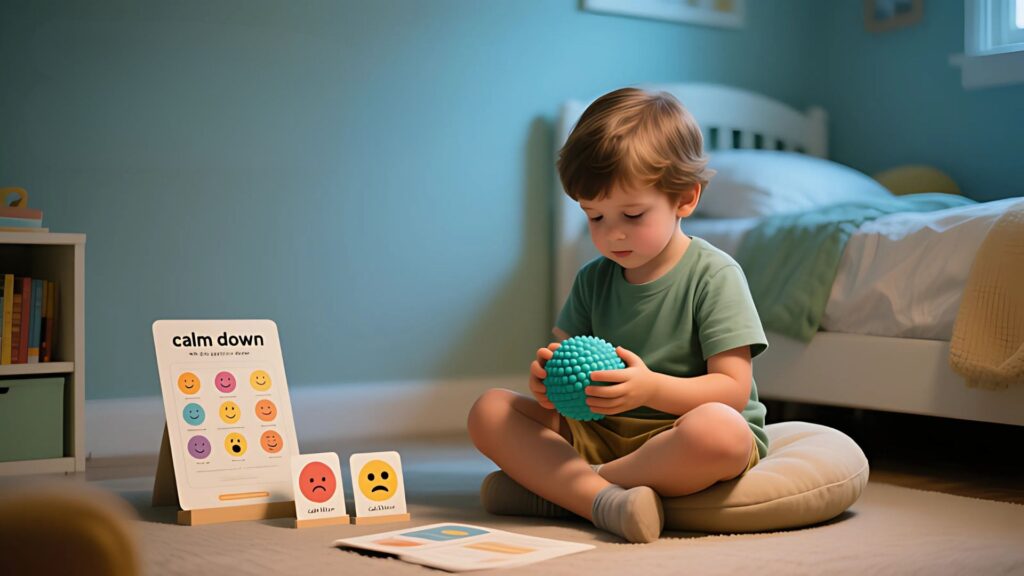
Jack felt like a volcano sometimes.
His feelings got big fast.
Sometimes small things made him upset.
Sometimes big things made him angry.
His face turned red. His hands clenched. His heart beat fast.
He didn’t like feeling this way.
He didn’t know how to stop.
One day, Ms. Clara said, “Jack, I have a story for you. It’s about calm down time. Do you want to hear it?”
Jack nodded. He liked stories.
The Story of Emma
“Once there was a girl named Emma,” Ms. Clara began.
“Emma loved playing with blocks and toys. Sometimes she got upset. Her tower fell. Someone took a toy. Someone said no. Emma felt her feelings grow like a storm.
One day, her teacher told her about calm down time. She said, ‘When your feelings get too big, take a break. Go to your calm spot. Breathe. Count. Relax.’
Emma tried it. She went to a quiet corner. She took a deep breath. She counted to ten. She stretched her arms. She felt the storm inside her get smaller.
After a few minutes, she returned to her friends. She felt ready. She felt calm. She could play again. Calm down time helped her.”
Jack listened carefully.
Maybe calm down time could help me too, he thought.
Practice at School
The next day, Jack felt upset during playtime.
Someone grabbed a toy he wanted.
He felt his face get red. His hands clenched.
He remembered Emma.
He walked to his calm down corner. He sat on a soft mat.
He took a deep breath.
He counted to ten.
He stretched his arms. He shook his hands gently.
He noticed his heart beat slower. His hands relaxed.
He felt calmer.
Jack returned to play. He shared the toy and smiled.
Calm Down at Home
At home, Jack sometimes felt upset too.
His sister wanted to play with his game.
He felt frustrated. He wanted to shout.
He remembered Emma. He went to his calm spot.
He took a breath. He counted. He calmed down.
When he returned, he said, “You can play first. I’ll wait.”
His sister smiled. Jack felt proud.
Small Steps to Calm Down
Ms. Clara taught Jack simple steps:
Step 1: Stop.
Step 2: Go to your calm spot.
Step 3: Sit or lie down comfortably.
Step 4: Take deep breaths.
Step 5: Count slowly to ten.
Step 6: Stretch or shake your hands.
Step 7: Notice your feelings getting smaller.
Step 8: Return when ready.
Jack practiced these steps every day.
Feeling Proud
Every time Jack used calm down time, he felt proud.
Every time he returned to play, he felt strong.
He realized he could control his feelings.
He realized he could be safe.
He realized he could be kind.
Using Calm Down Time With Friends
Sometimes Jack saw friends upset.
He reminded them, “Go to your calm spot. Breathe. Count.”
They tried. They felt calmer.
Jack felt happy helping others.
Learning From Mistakes
Sometimes Jack forgot.
Sometimes he got angry too fast.
Sometimes he didn’t want to go to his calm spot.
That was okay.
He tried again. Step by step. Day by day.
Calm Down in Real Life
Jack noticed calm down time worked everywhere.
At school.
At home.
At the playground.
During games.
Even when waiting in line.
Every time he practiced, he felt better.
Fun Practice
Jack made a chart.
Every time he used calm down time, he put a sticker on the chart.
At the end of the week, he counted the stickers.
He had many. He felt proud and strong.
Why Calm Down Time Helps
Jack learned calm down time helped him:
Feel safe.
Feel strong.
Feel proud.
Be kind.
Think clearly.
Play happily.
Steps for Everyone
Ms. Clara reminded the class:
“Feelings get big. That’s okay. What matters is what you do next. Calm down time helps you control your feelings. Practice makes it easier.”
Jack smiled. He understood.
Feeling Ready
Every time Jack felt upset, he remembered:
Stop. Go to calm spot. Breathe. Count. Stretch. Relax.
Step by step, the storm inside him got smaller.
He could return to play. He could share. He could have fun.
Helping Others Learn
Jack helped friends who forgot to use calm down time.
“It’s okay,” he said. “Go to your calm spot. Breathe.”
His friends felt calmer. Jack felt proud.
The Lesson
Jack learned an important lesson:
It’s okay to feel upset.
Feelings are normal.
Feelings can be big.
But you can control them.
Calm down time helps.
Step by step. Day by day.
The Ending
Jack still felt upset sometimes.
Sometimes he got angry fast.
But now he knew what to do.
Stop. Go to calm spot. Breathe. Count. Stretch. Relax.
He could control his feelings.
He could be kind.
He could be proud.
And every time he practiced, he remembered:
Calm down time helps me feel safe, strong, and ready to play.
Following Rules Keeps Me Safe
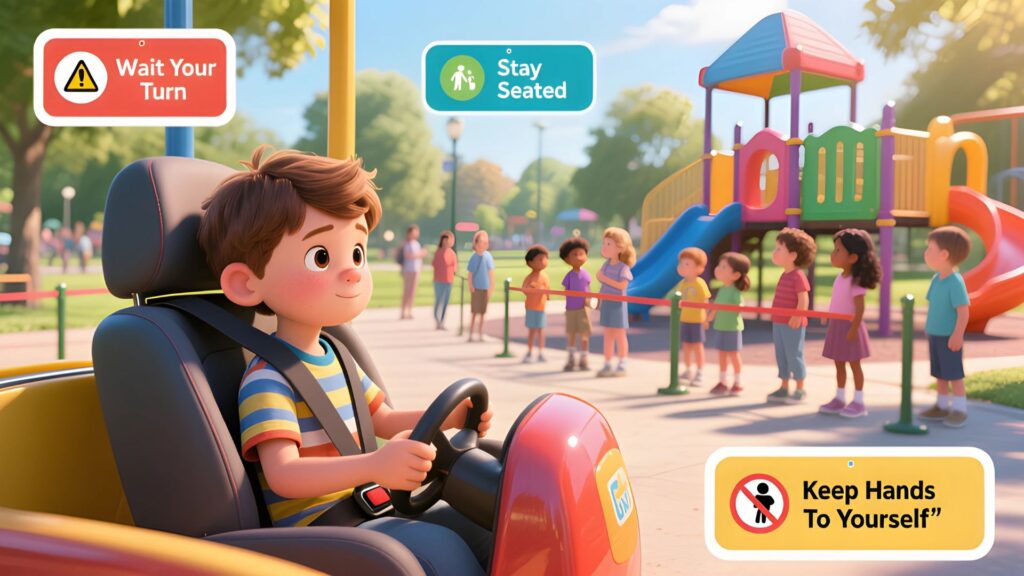
Maya liked to play.
She liked to run and climb.
Sometimes, she didn’t like rules.
She thought rules were annoying.
She thought rules slowed her down.
Sometimes, she forgot them.
Sometimes, she broke them on purpose.
One day, Ms. Clara said, “Maya, I have a story for you. It’s about following rules. Do you want to hear it?”
Maya nodded. She liked stories.
The Story of Liam
“Once there was a boy named Liam,” Ms. Clara began.
“Liam loved to ride his scooter. He liked going fast. Sometimes he didn’t follow the rules. He didn’t stop at the sidewalk. He didn’t wait for his turn.
One day, Liam almost bumped into another child. He felt scared. He realized rules helped him stay safe.
Liam decided to try following rules. He stopped at the sidewalk. He waited for his turn. He looked both ways before crossing.
He noticed something amazing. He could play safely. He could go fast without falling. He felt proud.
Following rules didn’t stop the fun. It made it safer. It made him feel strong. It made him feel happy.”
Maya listened carefully.
Maybe following rules can help me too, she thought.
Practice at School
The next day, Maya practiced rules at school.
Line up for lunch.
Wait her turn for the slide.
Listen when the teacher gave instructions.
She noticed it was easier to play.
She noticed everyone felt happier.
She felt proud.
Rules Keep Everyone Safe
Maya learned rules are not just for adults.
Rules help friends stay safe.
Rules help games be fair.
Rules help activities run smoothly.
Rules help you avoid accidents.
Maya noticed rules made her feel safe.
Learning From Mistakes
Sometimes, Maya forgot a rule.
Sometimes, she ran ahead in line.
Sometimes, she grabbed a toy first.
Her teacher reminded her gently.
“That’s okay,” Ms. Clara said. “Try again.”
Maya took a breath. She tried again.
She noticed that following rules became easier with practice.
Rules at Home
At home, Maya’s parents had rules too.
Wash hands before meals.
Pick up toys after playing.
Ask before taking snacks.
At first, Maya didn’t like these rules.
Sometimes she forgot.
Sometimes she wanted to do her own way.
Then she remembered Liam.
She followed the rules. She washed hands. She picked up toys.
Her parents smiled. Maya felt proud.
Rules Keep You Safe
Maya realized rules helped prevent accidents.
Stop at the street before crossing.
Hold the railing on stairs.
Wear a helmet when riding a bike.
Follow directions in class.
Rules keep her body safe.
Rules keep her friends safe.
Rules keep her happy.
Fun Practice
Ms. Clara suggested a game.
Every time Maya followed a rule, she got a sticker.
At the end of the week, she counted her stickers.
She had many. She felt proud and strong.
Rules in Play
During recess, Maya practiced rules:
Take turns on swings.
Share the ball.
Listen to the teacher.
Games were more fun when everyone followed rules.
Maya noticed her friends smiled more. She smiled too.
Steps to Follow Rules
Ms. Clara taught simple steps:
Step 1: Stop.
Step 2: Read or listen to the rule.
Step 3: Think, Why is this rule important?
Step 4: Follow the rule carefully.
Step 5: Notice the results.
Step 6: Feel proud.
Maya practiced these steps every day.
Feeling Proud
Every time Maya followed rules, she felt proud.
Every time she kept herself safe, she felt strong.
Every time she helped friends follow rules, she felt happy.
She noticed following rules didn’t make her weak.
It made her confident.
Helping Others
Sometimes, Maya reminded friends about rules.
“Let’s wait our turn,” she said.
“Hold the railing,” she said.
Her friends tried. They stayed safe. Maya felt proud helping them.
Learning From Mistakes
Sometimes, Maya forgot a rule.
Sometimes, she got distracted.
Sometimes, she wanted to do things her own way.
That was okay.
She tried again. Step by step. Day by day.
She got better. She noticed rules made life safer and happier.
Rules Everywhere
Maya noticed rules were everywhere.
At school.
At home.
At the playground.
On the street.
On the bus.
Every rule helped her stay safe.
Every rule helped others stay safe.
The Lesson
Maya learned an important lesson:
Rules are important.
Rules keep me safe.
Rules keep friends safe.
Rules help games be fair.
Rules help life be happy.
Step by step, day by day, following rules makes life better.
The Ending
Maya still wanted to run fast sometimes.
Sometimes she forgot.
Sometimes she wanted to do her own way.
But now she knew what to do.
Stop. Read. Think. Follow. Notice. Feel proud.
She could stay safe.
She could play happily.
She could help friends.
And every time she followed rules, she remembered:
Following rules keeps me safe, happy, and proud.
I Can Ask for Help
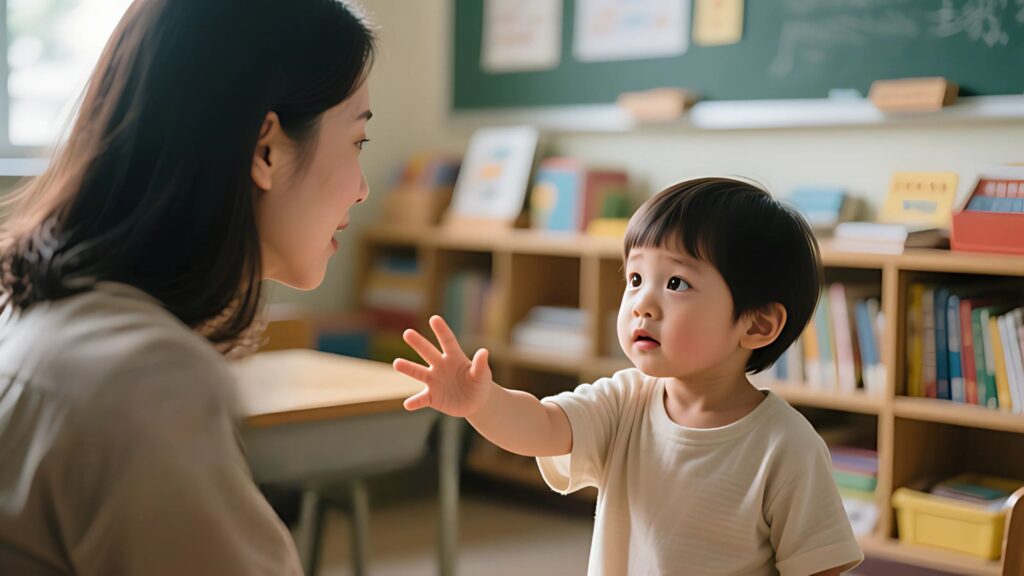
Sam liked to do things on his own.
He liked being independent.
He liked solving problems by himself.
Sometimes, he got stuck.
Sometimes, he felt frustrated.
Sometimes, he felt angry.
He didn’t like asking for help.
He thought it made him weak.
He thought others might be annoyed.
One day, Ms. Clara noticed Sam struggling with a puzzle.
“Sam,” she said gently, “it’s okay to ask for help. Asking for help is brave. Do you want a story about that?”
Sam nodded. He liked stories.
The Story of Mia
“Once there was a girl named Mia,” Ms. Clara began.
“Mia loved puzzles. She loved games. She liked solving problems.
One day, Mia tried a new puzzle. She got stuck. She felt frustrated. She wanted to give up.
Then she remembered something her mom told her: Asking for help is okay. It helps you learn.
Mia took a deep breath. She raised her hand. She said, ‘Can you help me, please?’
Her teacher came. She showed Mia a trick. Mia tried again.
The puzzle was still tricky. But Mia didn’t feel stuck anymore. She felt brave. She felt proud. She learned that asking for help can make things easier and more fun.”
Sam listened carefully.
Maybe asking for help is okay, he thought.
Practice at School
The next day, Sam faced a challenge in class.
A worksheet was hard.
He felt frustrated. His pencil hovered over the paper.
He remembered Mia.
He took a deep breath. He raised his hand.
“Can you help me, please?” he asked.
Ms. Clara came over. She explained the steps.
Sam followed the instructions.
He finished the worksheet.
He felt proud.
Learning From Mistakes
Sometimes, Sam forgot to ask for help.
Sometimes, he tried too hard by himself.
Sometimes, he felt stuck for a long time.
That was okay.
He tried again next time.
He noticed asking for help became easier.
Asking for Help at Home
At home, Sam struggled with a new game.
He wanted to figure it out alone.
He felt frustrated.
He remembered Mia.
He asked his mom, “Can you help me, please?”
His mom showed him a trick.
Sam played successfully. He felt proud.
He realized asking for help didn’t make him weak.
It made him stronger.
Small Steps to Ask for Help
Ms. Clara taught simple steps:
Step 1: Stop.
Step 2: Take a deep breath.
Step 3: Notice your feelings.
Step 4: Decide to ask for help.
Step 5: Use kind words: “Can you help me, please?”
Step 6: Listen carefully.
Step 7: Try again.
Step 8: Feel proud.
Sam practiced these steps every day.
Feeling Brave
Every time Sam asked for help, he felt brave.
Every time he learned something new, he felt proud.
He noticed that asking for help could save time.
It could make activities easier.
It could make games more fun.
Helping Others
Sometimes, Sam noticed friends struggling.
He reminded them gently, “You can ask for help.”
They tried. They felt better.
Sam felt happy helping his friends.
Challenges and Success
Sometimes, Sam felt shy.
Sometimes, he forgot the steps.
Sometimes, he worried about bothering others.
That was okay.
He tried again. Step by step. Day by day.
He noticed asking for help became easier each time.
Asking for Help in Real Life
Sam noticed asking for help worked everywhere.
At school.
At home.
At the playground.
During games.
Even when trying something new.
Every time he asked, he felt stronger.
Every time he tried again, he felt proud.
Fun Practice
Sam made a chart.
Every time he asked for help politely, he put a sticker on the chart.
At the end of the week, he counted his stickers.
He had many.
He felt proud and confident.
The Lesson
Sam learned an important lesson:
It’s okay to ask for help.
Asking for help doesn’t make you weak.
It helps you learn.
It helps you succeed.
It helps you feel proud.
It helps others know you care.
The Ending
Sam still liked to do things by himself.
Sometimes, he felt frustrated.
Sometimes, he felt stuck.
But now he knew what to do.
Stop. Breathe. Ask for help. Listen. Try again.
He could learn new things.
He could play successfully.
He could feel proud.
And every time he asked for help, he remembered:
I can ask for help. Asking for help is brave. Asking for help helps me learn and grow.
Waiting My Turn Is Cool
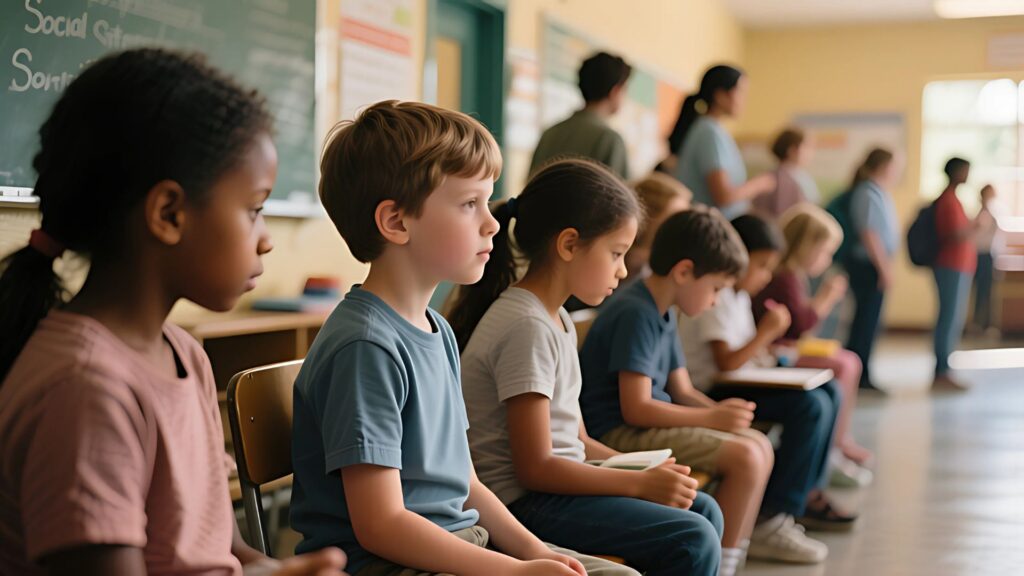
Ella loved playing games.
She loved going fast.
She loved winning.
Sometimes, she wanted everything at once.
Sometimes, she didn’t like waiting.
Sometimes, she grabbed toys.
Sometimes, she pushed in line.
Her friends got upset.
She felt frustrated too.
One day, Ms. Clara said, “Ella, I have a story for you. It’s about waiting your turn. Do you want to hear it?”
Ella nodded. She liked stories.
The Story of Leo
“Once there was a boy named Leo,” Ms. Clara began.
“Leo loved swings. He liked going high. He liked going fast.
Sometimes, he didn’t wait. He pushed in line. He grabbed the swing first.
His friends got upset. The teacher said, ‘Leo, waiting your turn is important.’
Leo felt frustrated. He wanted to go first.
Then he noticed something. When he waited, the swings were safer. Everyone smiled. The game was more fun.
Leo learned a secret: waiting his turn made play better. It helped friends be happy. It helped him have fun too.
He felt proud. He realized waiting wasn’t hard. It just took practice.”
Ella listened carefully.
Maybe waiting my turn can be cool, she thought.
Practice at School
The next day, Ella tried waiting her turn.
Line for the slide.
Line for the swing.
Line for the game.
At first, it was hard. She wanted to go first.
She remembered Leo. She took a deep breath. She waited.
She noticed something amazing.
Her friends smiled. She smiled. The game was fun.
She felt proud.
Waiting Helps Everyone
Ella learned waiting helps friends.
Waiting helps games be fair.
Waiting keeps activities safe.
Waiting helps everyone enjoy playtime.
She noticed her friends didn’t get upset. She felt calm.
She noticed she could have fun without rushing.
Learning From Mistakes
Sometimes, Ella forgot.
Sometimes, she pushed in line.
Sometimes, she grabbed toys too fast.
Her teacher reminded her gently.
“That’s okay,” Ms. Clara said. “Try again.”
Ella took a breath. She tried again. Step by step.
She noticed waiting became easier.
Waiting at Home
At home, Ella practiced waiting too.
Her brother wanted the tablet first.
She felt frustrated. She wanted it now.
She remembered Leo. She took a deep breath.
She said, “Okay, you go first. I’ll wait.”
Her brother smiled. She felt proud.
Waiting didn’t feel bad. It felt good.
Small Steps to Wait
Ms. Clara taught simple steps:
Step 1: Stop.
Step 2: Take a deep breath.
Step 3: Notice your feelings.
Step 4: Think, I can wait my turn.
Step 5: Count or play quietly while waiting.
Step 6: Follow the rules.
Step 7: Celebrate when it’s your turn.
Ella practiced these steps every day.
Feeling Proud
Every time Ella waited her turn, she felt proud.
Every time she followed the rules, she felt strong.
Every time her friends smiled, she felt happy.
She noticed waiting didn’t make her weak.
It made her confident.
Helping Others
Sometimes, Ella reminded friends about waiting.
“Let’s wait our turn,” she said.
Her friends tried. They smiled.
Ella felt proud helping them.
Challenges and Success
Sometimes, Ella felt impatient.
Sometimes, she forgot the steps.
Sometimes, she wanted to go fast.
That was okay.
She tried again. Step by step. Day by day.
She noticed waiting became easier.
Waiting in Real Life
Ella noticed waiting worked everywhere.
At school.
At home.
At the playground.
During games.
Even when lining up for snacks.
Every time she practiced, she felt calmer.
Every time she waited, she felt proud.
Fun Practice
Ella made a chart.
Every time she waited patiently, she put a sticker on the chart.
At the end of the week, she counted her stickers.
She had many. She felt proud and happy.
The Lesson
Ella learned an important lesson:
Waiting my turn is cool.
Waiting helps friends.
Waiting keeps games fair.
Waiting keeps me safe.
Waiting helps me feel proud.
Waiting makes play more fun.
Step by step, day by day, waiting becomes easier.
The Ending
Ella still wanted to go fast sometimes.
Sometimes she felt impatient.
Sometimes she forgot.
But now she knew what to do.
Stop. Breathe. Notice. Wait. Count. Play. Celebrate.
She could have fun.
She could play safely.
She could help friends.
And every time she waited her turn, she remembered:
Waiting my turn is cool, safe, and fun. And it makes me proud.
I Am in Charge of Me
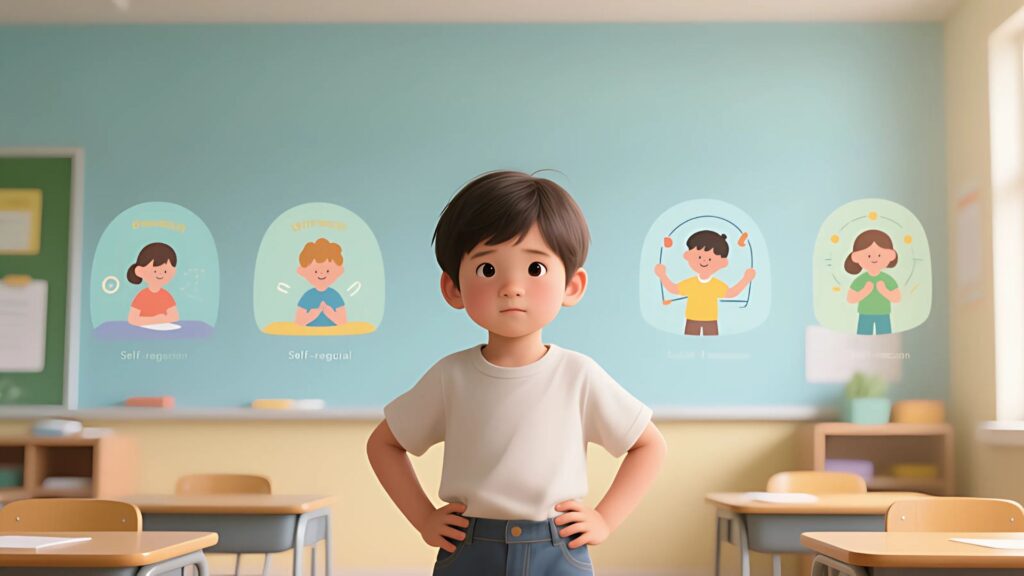
Ryan liked to run and play.
He liked to make choices.
Sometimes, he felt like he didn’t have control.
Sometimes, he got angry fast.
Sometimes, he blamed others.
Sometimes, he forgot he could make good choices.
One day, Ms. Clara said, “Ryan, I have a story for you. It’s about being in charge of yourself. Do you want to hear it?”
Ryan nodded. He liked stories.
The Story of Zoe
“Once there was a girl named Zoe,” Ms. Clara began.
“Zoe liked to play and have fun. Sometimes she felt upset. Sometimes she wanted to yell or push.
One day, her teacher told her: You are in charge of your feelings and actions. You can make choices.
Zoe was unsure. She had never thought about it that way.
The teacher showed her steps to be in charge:
- Stop.
- Notice your feelings.
- Take a deep breath.
- Think before acting.
- Choose what to do.
Zoe tried it. She felt angry. She wanted to yell.
She stopped. She breathed. She thought.
She chose to use her words. She said, ‘I feel upset. Can we take turns?’
Her friend listened. They took turns.
Zoe felt proud. She realized she could control herself. She could choose her actions. She was in charge.”
Ryan listened carefully.
Maybe I can be in charge of me too, he thought.
Practice at School
The next day, Ryan faced a challenge in class.
Someone took a toy he wanted.
He felt angry.
His face got red. His hands clenched.
He remembered Zoe. He stopped. He took a deep breath.
He thought, I can choose what to do.
He said, “Can I have a turn after you?”
The friend nodded.
Ryan felt proud. He realized he was in charge of himself.
Learning From Mistakes
Sometimes, Ryan forgot he was in charge.
Sometimes, he yelled.
Sometimes, he grabbed toys.
Sometimes, he felt out of control.
That was okay.
He tried again. Step by step.
He noticed being in charge became easier.
Being in Charge at Home
At home, Ryan practiced being in charge too.
His sister wanted the TV first.
He felt frustrated. He wanted it now.
He remembered Zoe. He stopped. He breathed.
He chose to wait his turn.
He felt proud.
Being in charge helped him feel calm.
Small Steps to Be in Charge
Ms. Clara taught simple steps:
Step 1: Stop.
Step 2: Notice your feelings.
Step 3: Take a deep breath.
Step 4: Think about choices.
Step 5: Choose what is safe and kind.
Step 6: Act on your choice.
Step 7: Notice how you feel.
Step 8: Feel proud.
Ryan practiced these steps every day.
Feeling Proud
Every time Ryan made a good choice, he felt proud.
Every time he stayed calm, he felt strong.
Every time he helped a friend, he felt happy.
He noticed being in charge didn’t mean he never felt upset.
It meant he could control what he did.
It meant he could choose wisely.
Helping Others
Sometimes, Ryan reminded friends they could be in charge too.
“You can choose what to do,” he said.
They tried. They felt better.
Ryan felt proud helping his friends.
Challenges and Success
Sometimes, Ryan felt angry too fast.
Sometimes, he forgot to stop and breathe.
Sometimes, he wanted to act without thinking.
That was okay.
He tried again. Step by step. Day by day.
He noticed being in charge became easier each time.
Being in Charge in Real Life
Ryan noticed being in charge worked everywhere.
At school.
At home.
At the playground.
During games.
Even when things didn’t go his way.
Every time he practiced, he felt stronger.
Every time he made a choice carefully, he felt proud.
Fun Practice
Ryan made a chart.
Every time he made a good choice, he put a sticker on the chart.
At the end of the week, he counted his stickers.
He had many.
He felt proud and confident.
The Lesson
Ryan learned an important lesson:
I am in charge of me.
I can notice my feelings.
I can take a breath.
I can think about choices.
I can choose what is safe and kind.
I can act wisely.
Step by step, day by day, being in charge becomes easier.
The Ending
Ryan still felt upset sometimes.
Sometimes he wanted to yell or push.
Sometimes he forgot to stop.
But now he knew what to do.
Stop. Breathe. Notice. Think. Choose. Act.
He could stay calm.
He could be safe.
He could help friends.
And every time he made a choice, he remembered:
I am in charge of me. I can make safe and kind choices. I can feel proud.
What Are Social Stories?
Social stories are short, simple stories that explain emotions and social situations. They don’t scold or lecture. They just show kids step by step how to handle feelings safely.
Instead of saying, “Stop yelling!” a social story might say:
- You feel angry when someone takes your toy.
- Feeling angry is okay.
- You can take a deep breath.
- You can ask politely for your turn.
These stories break big feelings into small steps. They hold a child’s hand through the storm until they can handle emotions on their own.
Why Social Stories Help?
Children with ODD often react quickly to strong emotions. Frustration can lead to yelling, arguing, or refusing instructions. Social stories give them a safe way to practice what to do.
For example, a story might show a child feeling jealous when a sibling gets attention first. Then it shows steps to cope:
- Notice the feeling (“I am jealous”)
- Take a deep breath
- Use words to ask for attention politely
Stories teach kids that feelings are normal, and that they have choices in how to respond.
Benefits
Social stories help kids:
- Name feelings: “I am frustrated” instead of yelling.
- Understand others: Learn that friends and family have feelings too.
- Calm down: Step-by-step instructions make it easier.
- Communicate: Find words for their emotions.
- Build confidence: Handling emotions makes them proud.
Think of social stories like a toolbox—each story gives a tool for managing strong feelings.
How They Work
A social story breaks things into clear, simple steps:
- Someone takes your toy.
- You feel angry.
- Take a deep breath or count to ten.
- Ask for your turn politely.
Stories show kids that emotions can be managed. They give options, so kids can respond safely instead of just reacting.
Making Your Own Stories
You don’t need to be an expert. Here’s how:
- Pick a situation: Something your child struggles with, like waiting or sharing.
- Describe it clearly: Short, simple sentences work best.
- Talk about feelings: Explain why your child or others feel that way.
- Show solutions: Breathing, counting, asking for help, or taking a quiet break.
- Practice together: Read the story and talk about how to use it in real life.
With time, these stories become mental guides kids can remember when they feel upset.
Using Stories Every Day
Stories work best when used often:
- Morning: Start the day calmly.
- Transitions: Move smoothly from one activity to another.
- Playtime: Practice sharing and taking turns.
- Conflict: Help kids calm down and solve problems.
The more kids practice, the easier it becomes for them to handle emotions on their own.
Emotional Growth
Social stories help children:
- Notice their feelings
- Calm down during frustration
- Understand others’ emotions
- Build empathy
They give kids a safe space to practice, making small successes feel big.
Common Themes
Stories often cover everyday challenges:
- Anger and frustration
- Sadness or disappointment
- Anxiety or nervousness
- Defiance or refusing instructions
- Sharing and cooperation
When stories match real experiences, kids understand and remember them better.
Tips for Parents
- Keep stories short and simple.
- Use pictures, drawings, or symbols.
- Read regularly, not just during conflicts.
- Discuss the story: “What would you do next?”
- Model calm behavior—kids learn by watching you.
Digital Stories
Digital stories can make learning fun:
- Animated videos
- Interactive stories where kids can make choices
- Apps usable at home, in the car, or at school
These tools keep kids engaged while learning to manage emotions.
Challenges
Some kids resist at first:
- “It’s boring” → Act it out with puppets or toys.
- “I don’t need this” → Connect it to something that happened that day.
- Forgetting strategies → Read often and practice together.
With patience, social stories become trusted guides for children.
Real-Life Impact
Parents notice changes like:
- Kids calm down faster
- More confidence in social situations
- Better interactions with family and friends
- Fewer arguments and meltdowns
Even simple stories can make everyday life smoother and calmer.
Making Stories a Routine
Use stories naturally in daily life:
- Bedtime: Talk about the day’s feelings
- Morning: Start the day calmly
- Playdates or school: Practice patience, sharing, and following rules
When used regularly, kids start using strategies on their own, without reminders.
Conclusion
Children with ODD experience emotions intensely. Daily life can feel like a storm—for them and the adults around them.
Social stories for kids with ODD are gentle, practical guides. They help children:
- Notice and name feelings
- Understand why they feel that way
- Respond in safe, healthy ways
Used consistently, these stories help kids grow confident, resilient, and empathetic, giving them tools to handle emotions and thrive every day.

